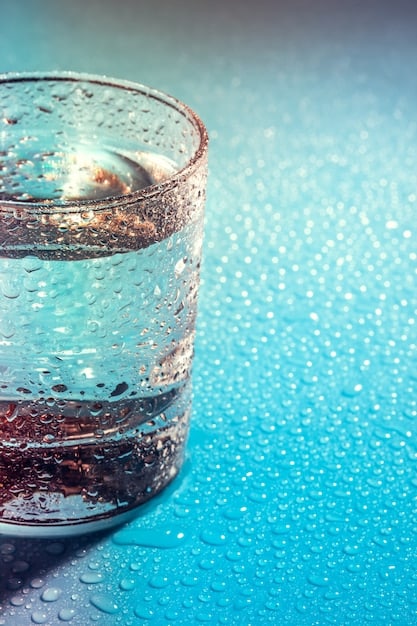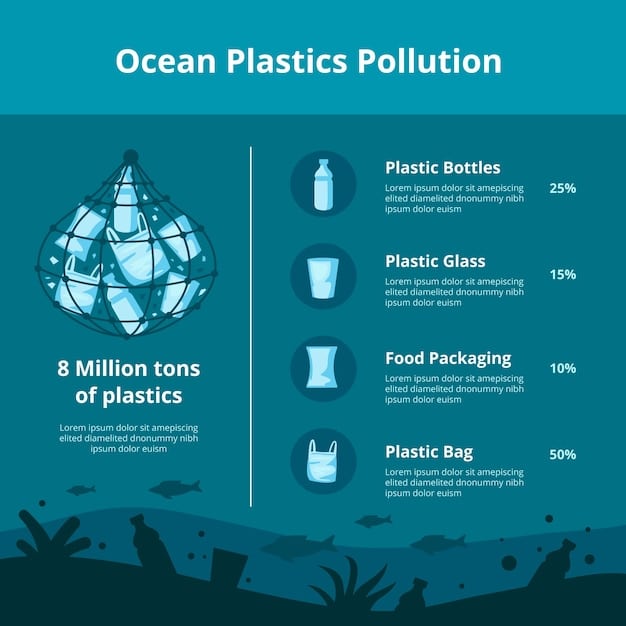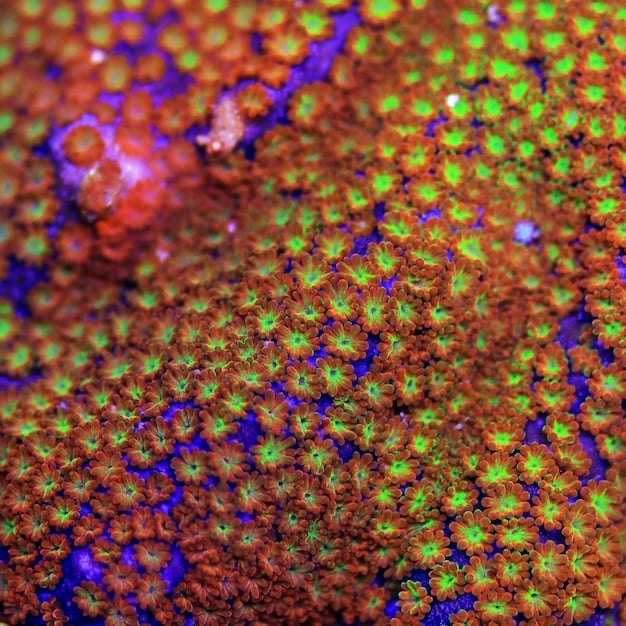Microplastics in Drinking Water: Long-Term Health Effects Examined

The long-term health effects of microplastics in drinking water are still under scientific investigation, but potential impacts include inflammation, immune responses, and exposure to harmful chemicals adsorbed onto the plastic particles.
Are you concerned about the potential health risks lurking in your tap water? This scientific review explores thelong-term health effects of microplastics in drinking water, shedding light on what the latest research reveals about these tiny particles and their potential impact on our bodies.
What Are Microplastics and Where Do They Come From?
Microplastics are small plastic particles ranging in size from 1 micrometer to 5 millimeters. They’ve become a pervasive environmental pollutant, finding their way into our oceans, soil, and, concerningly, our drinking water supplies.
Understanding the sources of these microplastics is crucial for addressing the problem at its root. Let’s delve into where they come from.
Sources of Microplastics in Drinking Water
Microplastics enter our drinking water through various pathways, both directly and indirectly. Identifying these sources is the first step towards mitigation.
- Plastic Degradation: Larger plastic items like bottles, bags, and packaging gradually break down into smaller fragments due to sunlight, weathering, and physical abrasion.
- Wastewater Treatment Plants: These plants, while essential for treating sewage, are not always effective at removing microplastics completely.
- Industrial Effluents: Manufacturing processes involving plastics can release microplastics directly into waterways.
- Agricultural Runoff: Plastic mulches and other agricultural plastics degrade over time, releasing microplastics that are carried into water systems by runoff.

The widespread presence of microplastics highlights the urgent need for improved waste management, advanced filtration technologies, and a reduction in overall plastic consumption.
The Science Behind Microplastic Toxicity
The toxicity of microplastics is a complex topic. Scientists are actively researching how these tiny particles interact with our bodies and what potential harm they may cause.
Several factors contribute to the potential toxicity of microplastics. Let’s examine some key aspects.
Key Factors in Microplastic Toxicity
Understanding these factors is important for assessing the true risk posed by microplastics in drinking water.
- Size and Shape: Smaller microplastics may be more easily absorbed into tissues and cells. The shape can also influence how they interact with biological systems.
- Chemical Composition: Different types of plastics contain different chemical additives, some of which may be toxic.
- Adsorbed Chemicals: Microplastics can act as carriers for other pollutants, such as heavy metals and persistent organic pollutants (POPs), effectively concentrating these toxins.
- Concentration: The level of microplastics present in drinking water is a critical factor in determining the extent of exposure and potential harm.
While the full extent of microplastic toxicity is still being investigated, these factors provide valuable insights into the potential mechanisms of harm.
Potential Long-Term Health Effects: What the Research Shows
Research into the long-term health effects of microplastics is still in its early stages, but some potential concerns have emerged from both animal and in vitro studies.
It’s important to note that most of the research so far has been conducted on animals, and more human studies are needed. However, these findings provide valuable clues about the possible risks.
Potential Health Concerns
Here are some of the potential health effects that have been linked to microplastic exposure in research studies.
Ingesting microplastics over extended periods may harm the human body. Research suggests potential hazards, although more studies are needed to fully understand these implications.
Consistently consuming microplastics may introduce harmful chemicals and other pollutants into the body. The extent of this, as well as the long-term effects, are still being researched.
- Inflammation: Microplastics can trigger inflammatory responses in various tissues, potentially leading to chronic diseases.
- Immune Responses: The immune system may react to microplastics as foreign invaders, potentially causing allergic reactions or autoimmune disorders.
- Endocrine Disruption: Some chemicals found in plastics can interfere with the endocrine system, disrupting hormonal balance.
- Organ Damage: Accumulation of microplastics in organs like the liver and kidneys could potentially lead to damage over time.

Microplastics and the Gut Microbiome
The gut microbiome is a complex community of microorganisms living in our digestive tract. It plays a crucial role in digestion, immunity, and overall health.
Emerging research suggests that microplastics may disrupt the delicate balance of the gut microbiome. Let’s explore how this might happen.
How Microplastics May Affect the Gut Microbiome
The interaction between microplastics and the gut microbiome is a complex area of research.
- Altering Microbial Composition: Microplastics may selectively promote the growth of certain bacteria while inhibiting others, leading to an imbalance in the gut microbiome.
- Disrupting Gut Barrier Function: Microplastics may damage the intestinal lining, compromising the gut barrier and allowing harmful substances to enter the bloodstream.
- Inflammation: Changes in the gut microbiome caused by microplastics can trigger inflammatory responses in the gut.
Further research is needed to fully understand the long-term consequences of microplastic-induced gut microbiome disruption.
Who is Most Vulnerable? Identifying At-Risk Populations
While the potential health risks of microplastics are a concern for everyone, certain populations may be more vulnerable to their effects.
Understanding who is most at risk can help us prioritize research and develop targeted interventions.
Identifying Vulnerable Groups
Several factors can contribute to increased vulnerability to microplastic exposure.
- Infants and Children: Their developing bodies may be more susceptible to the harmful effects of microplastics.
- Pregnant Women: Microplastics could potentially cross the placenta and affect fetal development.
- Individuals with Pre-existing Conditions: People with weakened immune systems or digestive disorders may be more vulnerable to the adverse effects of microplastics.
Protecting these vulnerable populations requires a multi-faceted approach, including reducing exposure to microplastics and strengthening overall health.
What Can You Do? Reducing Microplastic Exposure in Your Home
While the challenge of microplastic pollution is significant, there are steps you can take at home to minimize your exposure through drinking water.
Reducing your exposure can contribute to your overall health and well-being. Here are some practical measures you can take.
Practical Steps to Reduce Microplastic Exposure
Here are practical steps to minimize the impact of microplastics in your daily life.
Use water filters designed to remove microplastics effectively, ensuring you’re drinking cleaner water on a daily basis.
Opt for water filters specifically designed to remove microplastics and other contaminants. Choose reusable water bottles made from glass or stainless steel. Reduce your consumption of single-use plastic water bottles. Support policies and initiatives aimed at reducing plastic pollution. Educate yourself and others about the issue of microplastics and its potential health impacts.
- Use Water Filters: Install a high-quality water filter that is certified to remove microplastics.
- Choose Reusable Water Bottles: Opt for glass or stainless steel bottles instead of plastic.
- Reduce Plastic Consumption: Minimize your use of single-use plastics like water bottles, bags, and food containers.
By taking these proactive steps, you can significantly reduce your exposure to microplastics in drinking water and contribute to a healthier environment.
| Key Point | Brief Description |
|---|---|
| 💧Microplastic Sources | Plastic degradation, wastewater plants, and industrial effluents contribute to microplastics in water. |
| 🧪 Toxicity Factors | Size, shape, chemical composition, adsorbed chemicals, and concentration affect microplastic toxicity. |
| 🩺 Potential Health Effects | Inflammation, immune responses, endocrine disruption, and organ damage are potential risks. |
| 🛡️ Reducing Exposure | Use water filters, choose reusable bottles, and reduce plastic consumption. |
Frequently Asked Questions
Microplastics primarily originate from the degradation of larger plastic items, wastewater treatment plants, industrial effluents, and agricultural runoff. These sources release small plastic particles into water systems.
Microplastics can trigger inflammation, immune responses, and disrupt the endocrine system. They may also carry harmful chemicals into the body. The exact long-term effects are still under investigation.
Infants, children, and pregnant women are particularly vulnerable due to their developing bodies. People with pre-existing health conditions like weakened immune systems may also be at higher risk.
Water filters certified to remove microplastics, such as those using activated carbon or reverse osmosis, are effective. Look for filters that meet NSF standards for microplastic reduction.
You can minimize microplastic intake by using water filters, opting for reusable water bottles made of glass or stainless steel, and reducing your overall consumption of single-use plastics in your daily life.
Conclusion
While the long-term health effects of microplastics in drinking water are still being investigated, the potential risks warrant attention. By understanding the sources of microplastics, minimizing our exposure, and supporting further research, we can work towards protecting our health and the environment. Further scientific studies will help clarify the specific health impacts of these pollutants.





